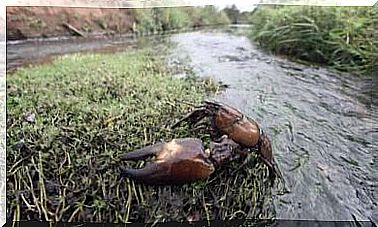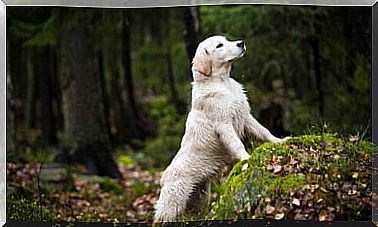The Grass Snake: A Nice Reptile Between Water And Earth
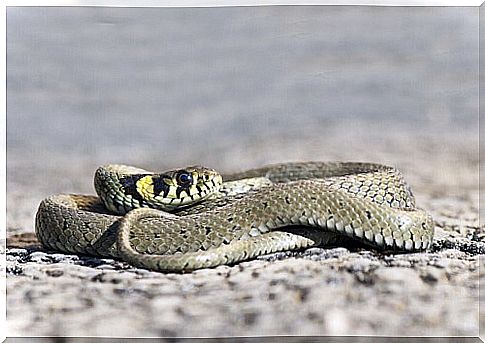
The grass snake is the name given to the species Natrix natrix, a nice-looking snake that lives in different areas of the world, from England to Lake Baikal in Siberia. A snake that, thanks to its great adaptability, manages to live in very different environments.
This reptile lives in Spain, France, Italy and many other European countries, so much so that it has become a typical species of the old continent. Although it has been used to living with human beings since ancient times, many people still do not know it and, seeing it, even come to fear for their life.
But there is nothing to fear, given that it is a totally harmless animal, which as a defense tool comes to fulfill its needs in front of the human who gets too close. If you want to find out more about the grass snake, read this article all the way through.
How to distinguish the snake from the collar?
It is possible that some of you have come across one of these specimens during some walking. According to some researches, it is estimated that only in Germany this species has the high population density of 3.6 specimens per hectare. We teach you how to identify it:
- It is a large reptile, as some specimens can measure up to two meters in length. On average, the grass snake reaches 120 centimeters.
- The coloration of this snake is very variable, but in most cases it ranges from green to light brown.
- It has a series of black spots on its back, which cover its body in groups of three to six lines.
- It has a distinctive, white neck surrounded by dark lines. It is to this characteristic that it owes its particular name.
- This is a characteristic typical only of young specimens, since it tends to disappear when the snake becomes adult.
Easy to distinguish, right? Attention, because the less experienced eyes could easily confuse this reptile with a relative species, the snake snake ( Natrix maura ). One way to tell them apart is their size, as the latter never exceeds 80 centimeters in length.
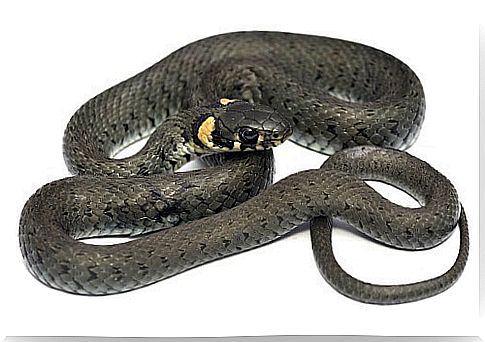
What are the habits of the grass snake?
According to certain sources, the grass snake eats mainly adult amphibians (which make up more than 60% of their diet), but also fish, tadpoles, earthworms and other small vertebrates. The diet of this reptile is due to its aquatic habits, as it loves to crawl in the waters of springs, wells, lakes and even man-made cisterns.
It is a snake with great swimming skills, which for this reason has become one of the nightmares of the anuran amphibians, which reach the springs to cool off or reproduce.
Its hunting skills are so good that some species of toad, such as the Epidalea calamita , have learned to identify chemical signals of this reptile’s presence. In this way they avoid the shelters impregnated by the smell of the grass snake, where they would certainly become their prey.
Like many other reptile species, the grass snake recedes during the winter. For this purpose, its natural habitat, the cold European forests, have little to offer in the winter months.
The grass snake comes out of its shelters with the rising spring temperatures and reproduces between April and May. Around July she has her brood of eggs ready, which hatch after about ten weeks.
A curious defensive strategy
The grass snake has no poison, which is why it must strive to escape from various predators. Adults, when faced with danger, try to escape. But if they are surrounded, they can exhibit a number of spectacular behaviors. Here are some of them:
- When surrounded, it takes a spiral shape with the body and withdraws the head, taking on a triangular shape. He then begins to snort and simulate attacks with his mouth closed. It does nothing but imitate the behavior and shape of vipers, extremely poisonous snakes.
- If these efforts don’t pay off and the predator hasn’t been fooled, he resorts to an even more extreme strategy: pretend to be dead. This reptile assumes a behavior called thanatosis, faking its own death to make the predator lose interest. He does this by throwing his head to the ground, opening his mouth and losing muscle tone.
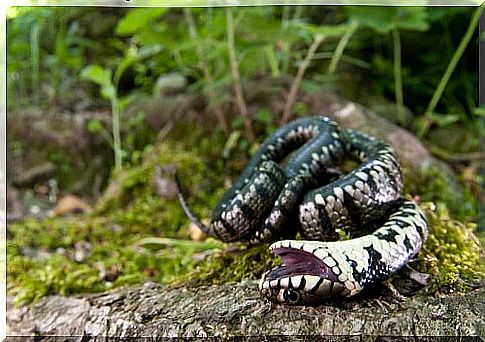
Grass snake: harmless and fascinating
As we have seen, even the seemingly most common animals have fascinating characteristics if we stop and observe them.
Who would ever say that a snake so easy to observe in courtyards and springs, assumes such a complex series of behaviors? This is nature, which provides all animals with the tools to facilitate their survival.


